Sydney Metro Project: Transport Planning and Policy Report
VerifiedAdded on 2023/06/04
|11
|3159
|460
Report
AI Summary
This report provides a comprehensive overview of the Sydney Metro project, Australia's largest public transport initiative. It delves into the project's background, highlighting its aim to provide faster and more reliable transportation between Sydney and Parramatta CBDs. The report discusses key features, including geotechnical investigations and temporary site establishments, and assesses the strengths and weaknesses of the project's appraisal. It outlines the various benefits expected upon completion, such as economic boosts, job creation, and improved connectivity. Furthermore, a literature review examines interchange considerations from both operator and passenger perspectives, emphasizing the importance of understanding passenger trip characteristics. The report concludes by underscoring the project's potential to generate new opportunities, contribute to high standards in rail project delivery, and foster community and environmental benefits through sustainable practices and collaborative partnerships.
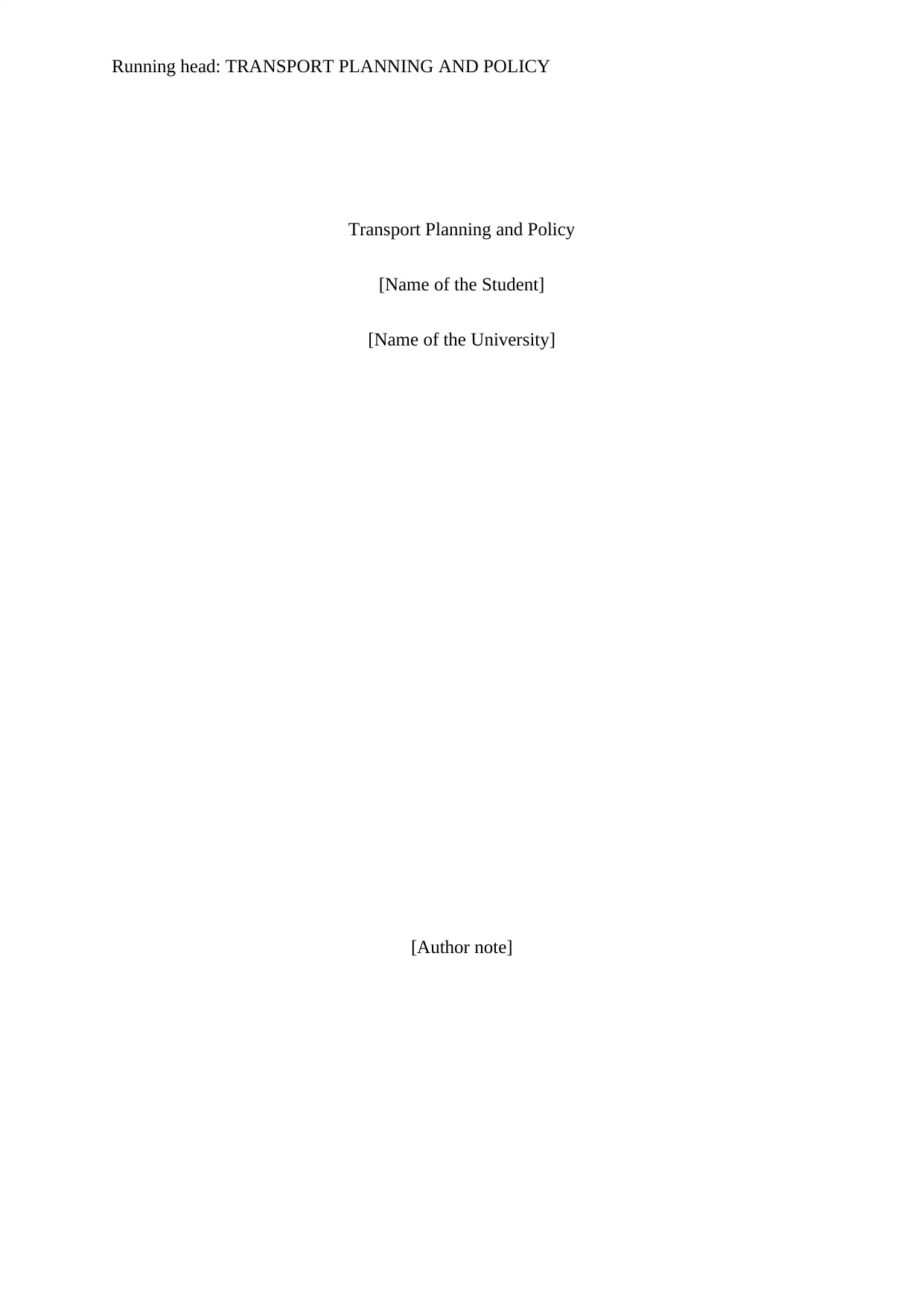
Running head: TRANSPORT PLANNING AND POLICY
Transport Planning and Policy
[Name of the Student]
[Name of the University]
[Author note]
Transport Planning and Policy
[Name of the Student]
[Name of the University]
[Author note]
Paraphrase This Document
Need a fresh take? Get an instant paraphrase of this document with our AI Paraphraser
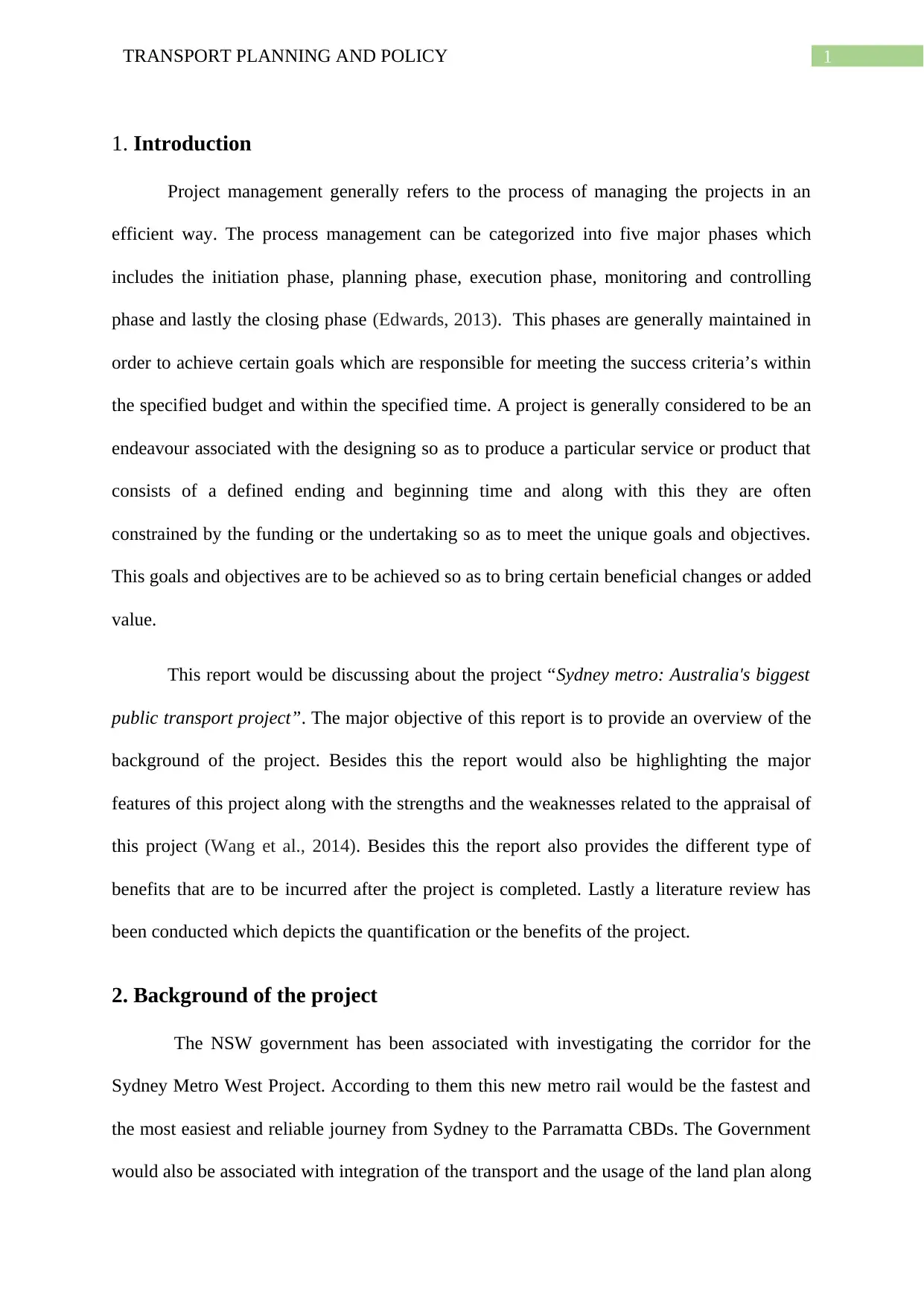
1TRANSPORT PLANNING AND POLICY
1. Introduction
Project management generally refers to the process of managing the projects in an
efficient way. The process management can be categorized into five major phases which
includes the initiation phase, planning phase, execution phase, monitoring and controlling
phase and lastly the closing phase (Edwards, 2013). This phases are generally maintained in
order to achieve certain goals which are responsible for meeting the success criteria’s within
the specified budget and within the specified time. A project is generally considered to be an
endeavour associated with the designing so as to produce a particular service or product that
consists of a defined ending and beginning time and along with this they are often
constrained by the funding or the undertaking so as to meet the unique goals and objectives.
This goals and objectives are to be achieved so as to bring certain beneficial changes or added
value.
This report would be discussing about the project “Sydney metro: Australia's biggest
public transport project”. The major objective of this report is to provide an overview of the
background of the project. Besides this the report would also be highlighting the major
features of this project along with the strengths and the weaknesses related to the appraisal of
this project (Wang et al., 2014). Besides this the report also provides the different type of
benefits that are to be incurred after the project is completed. Lastly a literature review has
been conducted which depicts the quantification or the benefits of the project.
2. Background of the project
The NSW government has been associated with investigating the corridor for the
Sydney Metro West Project. According to them this new metro rail would be the fastest and
the most easiest and reliable journey from Sydney to the Parramatta CBDs. The Government
would also be associated with integration of the transport and the usage of the land plan along
1. Introduction
Project management generally refers to the process of managing the projects in an
efficient way. The process management can be categorized into five major phases which
includes the initiation phase, planning phase, execution phase, monitoring and controlling
phase and lastly the closing phase (Edwards, 2013). This phases are generally maintained in
order to achieve certain goals which are responsible for meeting the success criteria’s within
the specified budget and within the specified time. A project is generally considered to be an
endeavour associated with the designing so as to produce a particular service or product that
consists of a defined ending and beginning time and along with this they are often
constrained by the funding or the undertaking so as to meet the unique goals and objectives.
This goals and objectives are to be achieved so as to bring certain beneficial changes or added
value.
This report would be discussing about the project “Sydney metro: Australia's biggest
public transport project”. The major objective of this report is to provide an overview of the
background of the project. Besides this the report would also be highlighting the major
features of this project along with the strengths and the weaknesses related to the appraisal of
this project (Wang et al., 2014). Besides this the report also provides the different type of
benefits that are to be incurred after the project is completed. Lastly a literature review has
been conducted which depicts the quantification or the benefits of the project.
2. Background of the project
The NSW government has been associated with investigating the corridor for the
Sydney Metro West Project. According to them this new metro rail would be the fastest and
the most easiest and reliable journey from Sydney to the Parramatta CBDs. The Government
would also be associated with integration of the transport and the usage of the land plan along

2TRANSPORT PLANNING AND POLICY
with the corridor with the new metro railway line that is expected to be built largely
underground (Selkrig et al., 2012). This new service would be starting from the year of 2019
in the North West section of the city where there would be trains available in every four
minutes during the peak timings of the day. Besides this there is also a planning of expanding
the metro rail in the year of 2014 to CBD and beyond to the Bankstown. The Sydney Metro
project includes new CBD raiway stations underground at the Martin Place as well as in Pitt
Street and Barangaroo. Besides this there would also be a new metro platform under central.
By the year of 2024 there would be around 32 new stations in the new rail system of 66 KM
which is considered to be the biggest urban rail project of Australian history which would be
having the ultimate capacity for the trains with a time interval of two minutes in all
directions.
3. Features and strength, weakness of the appraisal
The most important feature of this project is that a geotechnical investigation would
be conducted which would be assisting in the process of planning as well as in the process of
designing of the Sydney Metro West (Profillidis, 2016). The major reason lying behind this
investigation is for the purpose of determining the ground water along with the condition of
ground water along with the strength of the underlying rock over which the project work is to
be conducted. The major works included in the project includes the following:
a. Establishment of the temporary sites which would be including the security of the site
as well as fencing of the sites, which would be around 2 meters in length and 5 meters
in width.
b. Existence of a mobile drill rig for the purpose of drilling boreholes which are below
the ground level.
with the corridor with the new metro railway line that is expected to be built largely
underground (Selkrig et al., 2012). This new service would be starting from the year of 2019
in the North West section of the city where there would be trains available in every four
minutes during the peak timings of the day. Besides this there is also a planning of expanding
the metro rail in the year of 2014 to CBD and beyond to the Bankstown. The Sydney Metro
project includes new CBD raiway stations underground at the Martin Place as well as in Pitt
Street and Barangaroo. Besides this there would also be a new metro platform under central.
By the year of 2024 there would be around 32 new stations in the new rail system of 66 KM
which is considered to be the biggest urban rail project of Australian history which would be
having the ultimate capacity for the trains with a time interval of two minutes in all
directions.
3. Features and strength, weakness of the appraisal
The most important feature of this project is that a geotechnical investigation would
be conducted which would be assisting in the process of planning as well as in the process of
designing of the Sydney Metro West (Profillidis, 2016). The major reason lying behind this
investigation is for the purpose of determining the ground water along with the condition of
ground water along with the strength of the underlying rock over which the project work is to
be conducted. The major works included in the project includes the following:
a. Establishment of the temporary sites which would be including the security of the site
as well as fencing of the sites, which would be around 2 meters in length and 5 meters
in width.
b. Existence of a mobile drill rig for the purpose of drilling boreholes which are below
the ground level.
⊘ This is a preview!⊘
Do you want full access?
Subscribe today to unlock all pages.

Trusted by 1+ million students worldwide
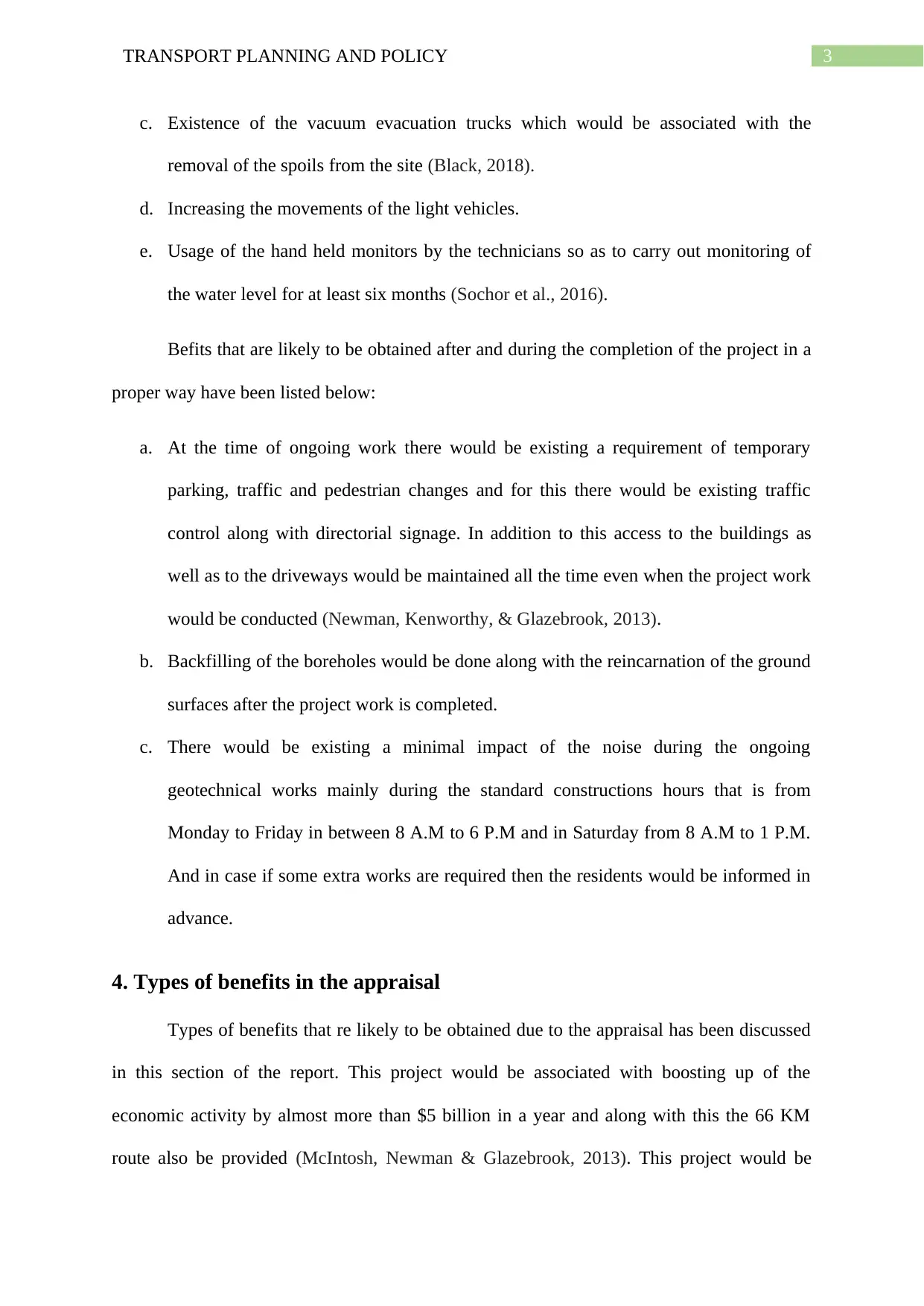
3TRANSPORT PLANNING AND POLICY
c. Existence of the vacuum evacuation trucks which would be associated with the
removal of the spoils from the site (Black, 2018).
d. Increasing the movements of the light vehicles.
e. Usage of the hand held monitors by the technicians so as to carry out monitoring of
the water level for at least six months (Sochor et al., 2016).
Befits that are likely to be obtained after and during the completion of the project in a
proper way have been listed below:
a. At the time of ongoing work there would be existing a requirement of temporary
parking, traffic and pedestrian changes and for this there would be existing traffic
control along with directorial signage. In addition to this access to the buildings as
well as to the driveways would be maintained all the time even when the project work
would be conducted (Newman, Kenworthy, & Glazebrook, 2013).
b. Backfilling of the boreholes would be done along with the reincarnation of the ground
surfaces after the project work is completed.
c. There would be existing a minimal impact of the noise during the ongoing
geotechnical works mainly during the standard constructions hours that is from
Monday to Friday in between 8 A.M to 6 P.M and in Saturday from 8 A.M to 1 P.M.
And in case if some extra works are required then the residents would be informed in
advance.
4. Types of benefits in the appraisal
Types of benefits that re likely to be obtained due to the appraisal has been discussed
in this section of the report. This project would be associated with boosting up of the
economic activity by almost more than $5 billion in a year and along with this the 66 KM
route also be provided (McIntosh, Newman & Glazebrook, 2013). This project would be
c. Existence of the vacuum evacuation trucks which would be associated with the
removal of the spoils from the site (Black, 2018).
d. Increasing the movements of the light vehicles.
e. Usage of the hand held monitors by the technicians so as to carry out monitoring of
the water level for at least six months (Sochor et al., 2016).
Befits that are likely to be obtained after and during the completion of the project in a
proper way have been listed below:
a. At the time of ongoing work there would be existing a requirement of temporary
parking, traffic and pedestrian changes and for this there would be existing traffic
control along with directorial signage. In addition to this access to the buildings as
well as to the driveways would be maintained all the time even when the project work
would be conducted (Newman, Kenworthy, & Glazebrook, 2013).
b. Backfilling of the boreholes would be done along with the reincarnation of the ground
surfaces after the project work is completed.
c. There would be existing a minimal impact of the noise during the ongoing
geotechnical works mainly during the standard constructions hours that is from
Monday to Friday in between 8 A.M to 6 P.M and in Saturday from 8 A.M to 1 P.M.
And in case if some extra works are required then the residents would be informed in
advance.
4. Types of benefits in the appraisal
Types of benefits that re likely to be obtained due to the appraisal has been discussed
in this section of the report. This project would be associated with boosting up of the
economic activity by almost more than $5 billion in a year and along with this the 66 KM
route also be provided (McIntosh, Newman & Glazebrook, 2013). This project would be
Paraphrase This Document
Need a fresh take? Get an instant paraphrase of this document with our AI Paraphraser
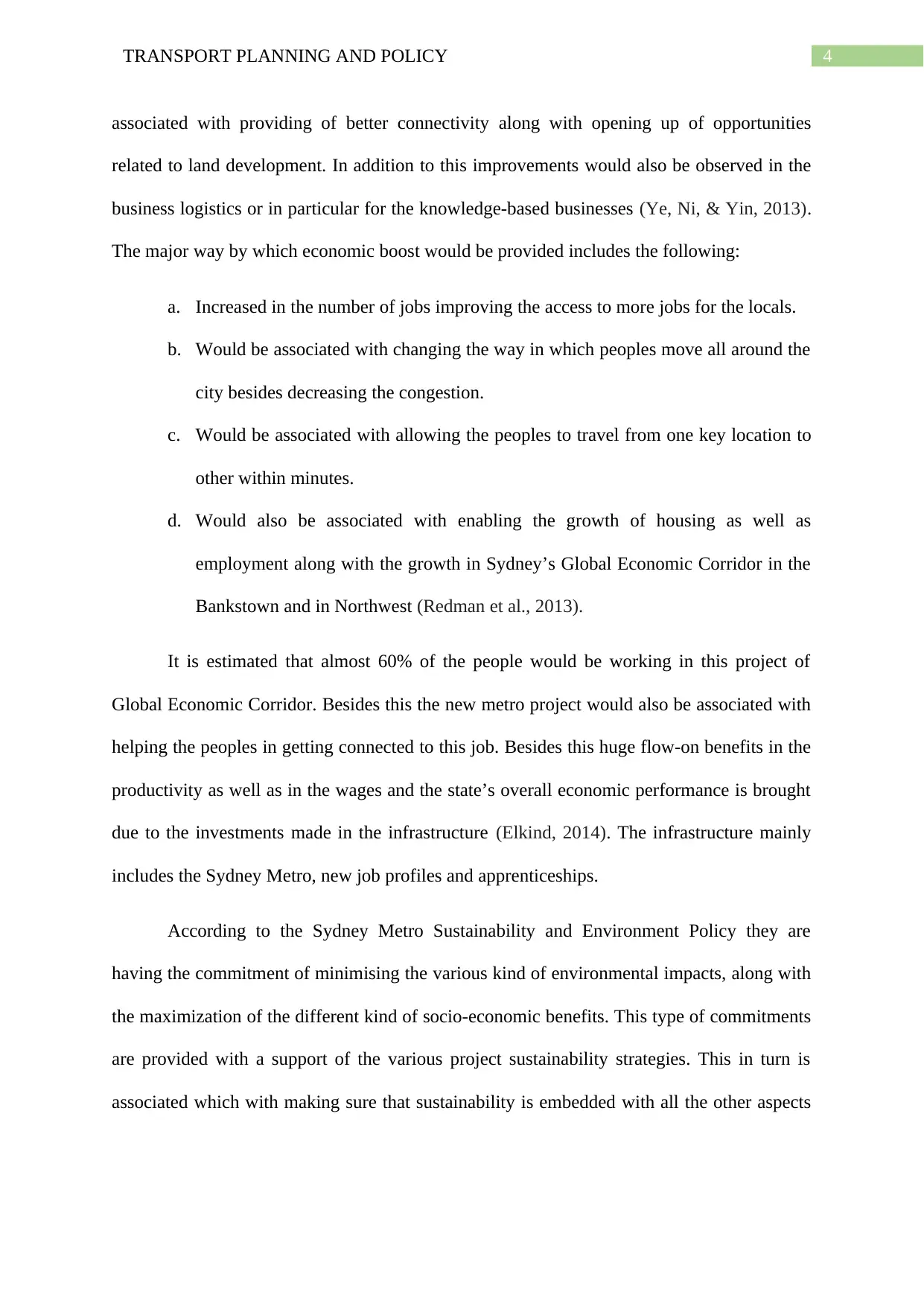
4TRANSPORT PLANNING AND POLICY
associated with providing of better connectivity along with opening up of opportunities
related to land development. In addition to this improvements would also be observed in the
business logistics or in particular for the knowledge-based businesses (Ye, Ni, & Yin, 2013).
The major way by which economic boost would be provided includes the following:
a. Increased in the number of jobs improving the access to more jobs for the locals.
b. Would be associated with changing the way in which peoples move all around the
city besides decreasing the congestion.
c. Would be associated with allowing the peoples to travel from one key location to
other within minutes.
d. Would also be associated with enabling the growth of housing as well as
employment along with the growth in Sydney’s Global Economic Corridor in the
Bankstown and in Northwest (Redman et al., 2013).
It is estimated that almost 60% of the people would be working in this project of
Global Economic Corridor. Besides this the new metro project would also be associated with
helping the peoples in getting connected to this job. Besides this huge flow-on benefits in the
productivity as well as in the wages and the state’s overall economic performance is brought
due to the investments made in the infrastructure (Elkind, 2014). The infrastructure mainly
includes the Sydney Metro, new job profiles and apprenticeships.
According to the Sydney Metro Sustainability and Environment Policy they are
having the commitment of minimising the various kind of environmental impacts, along with
the maximization of the different kind of socio-economic benefits. This type of commitments
are provided with a support of the various project sustainability strategies. This in turn is
associated which with making sure that sustainability is embedded with all the other aspects
associated with providing of better connectivity along with opening up of opportunities
related to land development. In addition to this improvements would also be observed in the
business logistics or in particular for the knowledge-based businesses (Ye, Ni, & Yin, 2013).
The major way by which economic boost would be provided includes the following:
a. Increased in the number of jobs improving the access to more jobs for the locals.
b. Would be associated with changing the way in which peoples move all around the
city besides decreasing the congestion.
c. Would be associated with allowing the peoples to travel from one key location to
other within minutes.
d. Would also be associated with enabling the growth of housing as well as
employment along with the growth in Sydney’s Global Economic Corridor in the
Bankstown and in Northwest (Redman et al., 2013).
It is estimated that almost 60% of the people would be working in this project of
Global Economic Corridor. Besides this the new metro project would also be associated with
helping the peoples in getting connected to this job. Besides this huge flow-on benefits in the
productivity as well as in the wages and the state’s overall economic performance is brought
due to the investments made in the infrastructure (Elkind, 2014). The infrastructure mainly
includes the Sydney Metro, new job profiles and apprenticeships.
According to the Sydney Metro Sustainability and Environment Policy they are
having the commitment of minimising the various kind of environmental impacts, along with
the maximization of the different kind of socio-economic benefits. This type of commitments
are provided with a support of the various project sustainability strategies. This in turn is
associated which with making sure that sustainability is embedded with all the other aspects
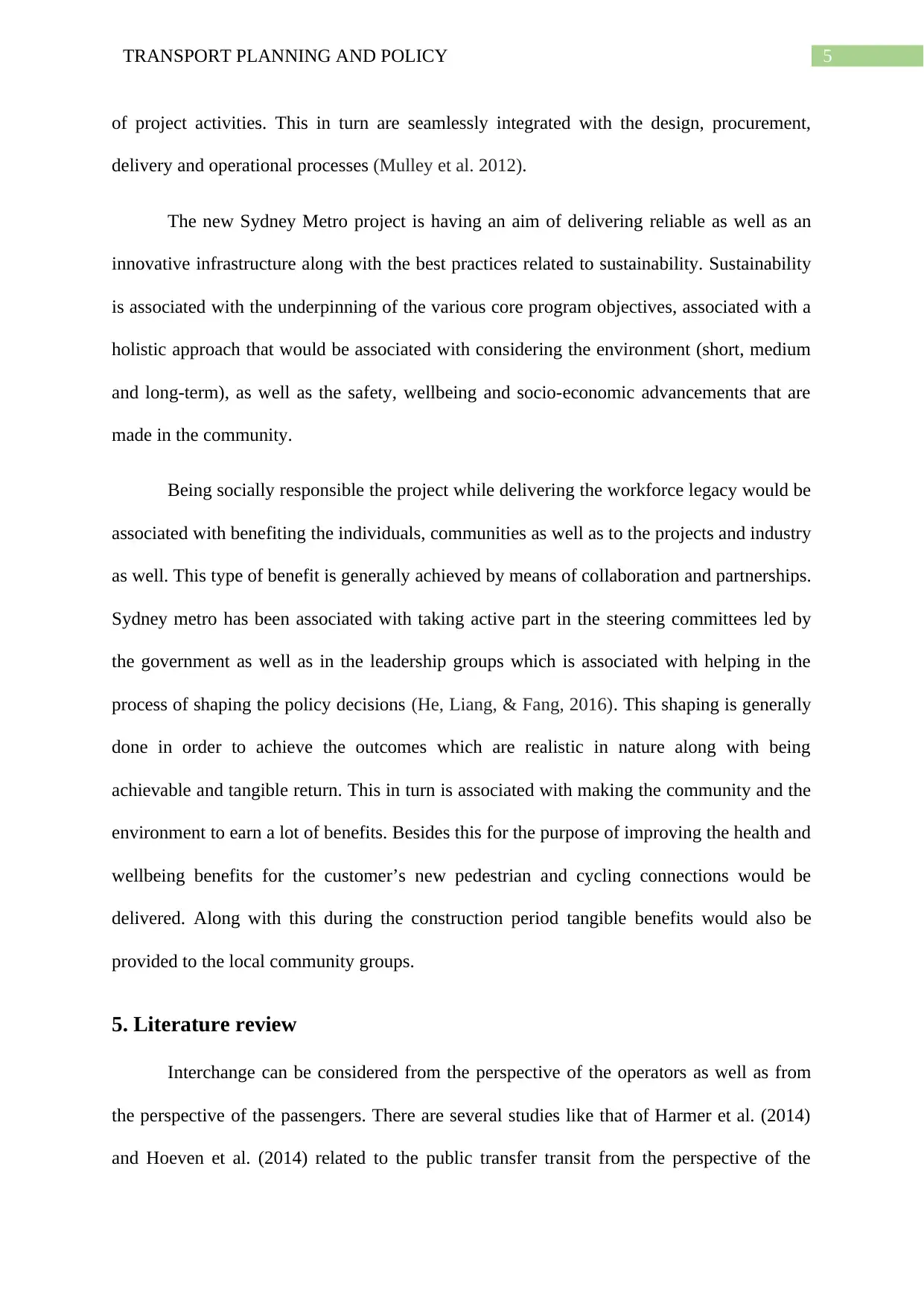
5TRANSPORT PLANNING AND POLICY
of project activities. This in turn are seamlessly integrated with the design, procurement,
delivery and operational processes (Mulley et al. 2012).
The new Sydney Metro project is having an aim of delivering reliable as well as an
innovative infrastructure along with the best practices related to sustainability. Sustainability
is associated with the underpinning of the various core program objectives, associated with a
holistic approach that would be associated with considering the environment (short, medium
and long-term), as well as the safety, wellbeing and socio-economic advancements that are
made in the community.
Being socially responsible the project while delivering the workforce legacy would be
associated with benefiting the individuals, communities as well as to the projects and industry
as well. This type of benefit is generally achieved by means of collaboration and partnerships.
Sydney metro has been associated with taking active part in the steering committees led by
the government as well as in the leadership groups which is associated with helping in the
process of shaping the policy decisions (He, Liang, & Fang, 2016). This shaping is generally
done in order to achieve the outcomes which are realistic in nature along with being
achievable and tangible return. This in turn is associated with making the community and the
environment to earn a lot of benefits. Besides this for the purpose of improving the health and
wellbeing benefits for the customer’s new pedestrian and cycling connections would be
delivered. Along with this during the construction period tangible benefits would also be
provided to the local community groups.
5. Literature review
Interchange can be considered from the perspective of the operators as well as from
the perspective of the passengers. There are several studies like that of Harmer et al. (2014)
and Hoeven et al. (2014) related to the public transfer transit from the perspective of the
of project activities. This in turn are seamlessly integrated with the design, procurement,
delivery and operational processes (Mulley et al. 2012).
The new Sydney Metro project is having an aim of delivering reliable as well as an
innovative infrastructure along with the best practices related to sustainability. Sustainability
is associated with the underpinning of the various core program objectives, associated with a
holistic approach that would be associated with considering the environment (short, medium
and long-term), as well as the safety, wellbeing and socio-economic advancements that are
made in the community.
Being socially responsible the project while delivering the workforce legacy would be
associated with benefiting the individuals, communities as well as to the projects and industry
as well. This type of benefit is generally achieved by means of collaboration and partnerships.
Sydney metro has been associated with taking active part in the steering committees led by
the government as well as in the leadership groups which is associated with helping in the
process of shaping the policy decisions (He, Liang, & Fang, 2016). This shaping is generally
done in order to achieve the outcomes which are realistic in nature along with being
achievable and tangible return. This in turn is associated with making the community and the
environment to earn a lot of benefits. Besides this for the purpose of improving the health and
wellbeing benefits for the customer’s new pedestrian and cycling connections would be
delivered. Along with this during the construction period tangible benefits would also be
provided to the local community groups.
5. Literature review
Interchange can be considered from the perspective of the operators as well as from
the perspective of the passengers. There are several studies like that of Harmer et al. (2014)
and Hoeven et al. (2014) related to the public transfer transit from the perspective of the
⊘ This is a preview!⊘
Do you want full access?
Subscribe today to unlock all pages.

Trusted by 1+ million students worldwide

6TRANSPORT PLANNING AND POLICY
operator and is including the intermodal transfer facility design. This was mainly related to
the location for the transfers, the unreliability ad the network accessibility and lastly the
public transport coverage. The literature is extensive in nature but in common there is the
tendency which is associated with treating the passengers as the homogenous segments. This
is generally done without considering the trip characteristics of the passenger while
evaluating the effects of the transfer. The characteristics of the trip are generally considered
to be the most significant factors responsible for the selection of the mode of transport by the
passenger. So it is essential to take into account the process of studying the interchangeable
behaviour of the passengers. However the major limitation of this paper is that the travel
behaviour literature have been associated with looking into the impact upon the users related
to some of the aspects of the trip which includes the impact that the transfer penalties are
having upon the value of time in travel.
Iseki and Taylor (2009), have been associated with including the transfer penalty as a part of
the generalized cost that the passengers are having. Which is generally obtained by
classifying of the important factor related to the user that mainly includes the costs, time,
scheduling and the facilities of the transfer attributes. This was extended by other authors like
Guo and Wilson (2011), and this mainly included considering of the transfer costs which is
generally dependent upon the operator service supply as well as upon the perceptions of the
customer.
According to Chowdhury and Ceder (2013), there exists five attributes in the passenger
defined perception planned transfer. Besides this they also found that the willingness of the
public transport users in order to use the transfer route is also increasing in case if there exists
a better communication between the public transport modes that are provided. Besides this
they also highlighted the fact that the travel time is seen to be more significant than the time
needed for waiting and for walking and this is especially for the commuters.
operator and is including the intermodal transfer facility design. This was mainly related to
the location for the transfers, the unreliability ad the network accessibility and lastly the
public transport coverage. The literature is extensive in nature but in common there is the
tendency which is associated with treating the passengers as the homogenous segments. This
is generally done without considering the trip characteristics of the passenger while
evaluating the effects of the transfer. The characteristics of the trip are generally considered
to be the most significant factors responsible for the selection of the mode of transport by the
passenger. So it is essential to take into account the process of studying the interchangeable
behaviour of the passengers. However the major limitation of this paper is that the travel
behaviour literature have been associated with looking into the impact upon the users related
to some of the aspects of the trip which includes the impact that the transfer penalties are
having upon the value of time in travel.
Iseki and Taylor (2009), have been associated with including the transfer penalty as a part of
the generalized cost that the passengers are having. Which is generally obtained by
classifying of the important factor related to the user that mainly includes the costs, time,
scheduling and the facilities of the transfer attributes. This was extended by other authors like
Guo and Wilson (2011), and this mainly included considering of the transfer costs which is
generally dependent upon the operator service supply as well as upon the perceptions of the
customer.
According to Chowdhury and Ceder (2013), there exists five attributes in the passenger
defined perception planned transfer. Besides this they also found that the willingness of the
public transport users in order to use the transfer route is also increasing in case if there exists
a better communication between the public transport modes that are provided. Besides this
they also highlighted the fact that the travel time is seen to be more significant than the time
needed for waiting and for walking and this is especially for the commuters.
Paraphrase This Document
Need a fresh take? Get an instant paraphrase of this document with our AI Paraphraser
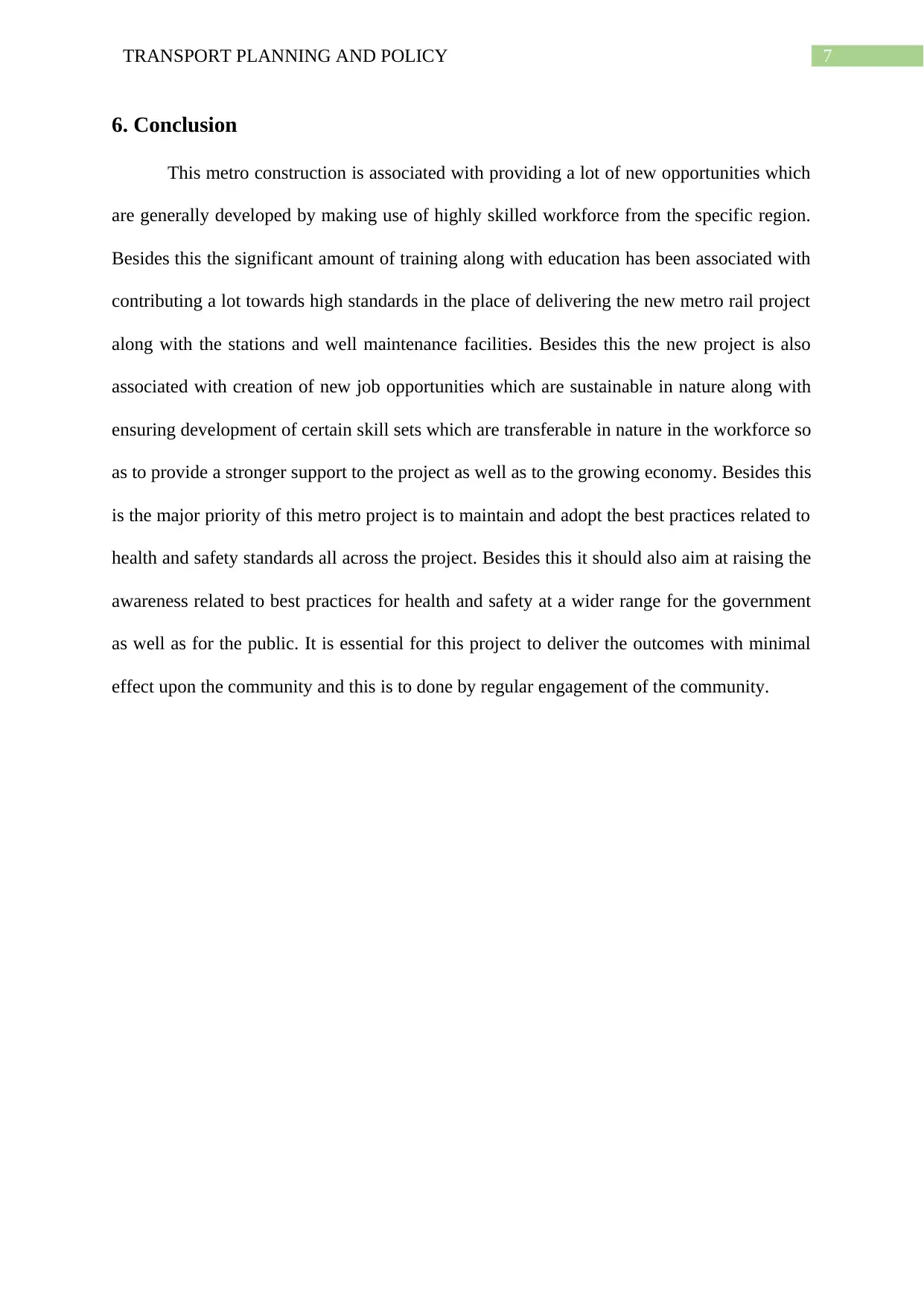
7TRANSPORT PLANNING AND POLICY
6. Conclusion
This metro construction is associated with providing a lot of new opportunities which
are generally developed by making use of highly skilled workforce from the specific region.
Besides this the significant amount of training along with education has been associated with
contributing a lot towards high standards in the place of delivering the new metro rail project
along with the stations and well maintenance facilities. Besides this the new project is also
associated with creation of new job opportunities which are sustainable in nature along with
ensuring development of certain skill sets which are transferable in nature in the workforce so
as to provide a stronger support to the project as well as to the growing economy. Besides this
is the major priority of this metro project is to maintain and adopt the best practices related to
health and safety standards all across the project. Besides this it should also aim at raising the
awareness related to best practices for health and safety at a wider range for the government
as well as for the public. It is essential for this project to deliver the outcomes with minimal
effect upon the community and this is to done by regular engagement of the community.
6. Conclusion
This metro construction is associated with providing a lot of new opportunities which
are generally developed by making use of highly skilled workforce from the specific region.
Besides this the significant amount of training along with education has been associated with
contributing a lot towards high standards in the place of delivering the new metro rail project
along with the stations and well maintenance facilities. Besides this the new project is also
associated with creation of new job opportunities which are sustainable in nature along with
ensuring development of certain skill sets which are transferable in nature in the workforce so
as to provide a stronger support to the project as well as to the growing economy. Besides this
is the major priority of this metro project is to maintain and adopt the best practices related to
health and safety standards all across the project. Besides this it should also aim at raising the
awareness related to best practices for health and safety at a wider range for the government
as well as for the public. It is essential for this project to deliver the outcomes with minimal
effect upon the community and this is to done by regular engagement of the community.

8TRANSPORT PLANNING AND POLICY
References:
Edwards, B. (2013). The modern station: new approaches to railway architecture. Taylor &
Francis.
Newman, P., Kenworthy, J., & Glazebrook, G. (2013). Peak car use and the rise of global
rail: why this is happening and what it means for large and small cities. Journal of
Transportation Technologies, 3.
Profillidis, V. (2016). Railway management and engineering. Routledge.
Wang, Q. K., Li, P., Xiao, Y. P., & Liu, Z. G. (2014). Integration of GIS and BIM in Metro
Construction. In Applied Mechanics and Materials (Vol. 608, pp. 698-702). Trans
Tech Publications.
Ye, X. W., Ni, Y. Q., & Yin, J. H. (2013). Safety monitoring of railway tunnel construction
using FBG sensing technology. Advances in Structural Engineering, 16(8), 1401-
1409.
Selkrig, J., Mosbahi, K., Webb, C. T., Belousoff, M. J., Perry, A. J., Wells, T. J., ... & Celik,
N. (2012). Discovery of an archetypal protein transport system in bacterial outer
membranes. Nature Structural and Molecular Biology, 19(5), 506.
Redman, L., Friman, M., Gärling, T., & Hartig, T. (2013). Quality attributes of public
transport that attract car users: A research review. Transport Policy, 25, 119-127.
Black, J. (2018). Urban transport planning: Theory and practice. Routledge.
References:
Edwards, B. (2013). The modern station: new approaches to railway architecture. Taylor &
Francis.
Newman, P., Kenworthy, J., & Glazebrook, G. (2013). Peak car use and the rise of global
rail: why this is happening and what it means for large and small cities. Journal of
Transportation Technologies, 3.
Profillidis, V. (2016). Railway management and engineering. Routledge.
Wang, Q. K., Li, P., Xiao, Y. P., & Liu, Z. G. (2014). Integration of GIS and BIM in Metro
Construction. In Applied Mechanics and Materials (Vol. 608, pp. 698-702). Trans
Tech Publications.
Ye, X. W., Ni, Y. Q., & Yin, J. H. (2013). Safety monitoring of railway tunnel construction
using FBG sensing technology. Advances in Structural Engineering, 16(8), 1401-
1409.
Selkrig, J., Mosbahi, K., Webb, C. T., Belousoff, M. J., Perry, A. J., Wells, T. J., ... & Celik,
N. (2012). Discovery of an archetypal protein transport system in bacterial outer
membranes. Nature Structural and Molecular Biology, 19(5), 506.
Redman, L., Friman, M., Gärling, T., & Hartig, T. (2013). Quality attributes of public
transport that attract car users: A research review. Transport Policy, 25, 119-127.
Black, J. (2018). Urban transport planning: Theory and practice. Routledge.
⊘ This is a preview!⊘
Do you want full access?
Subscribe today to unlock all pages.

Trusted by 1+ million students worldwide
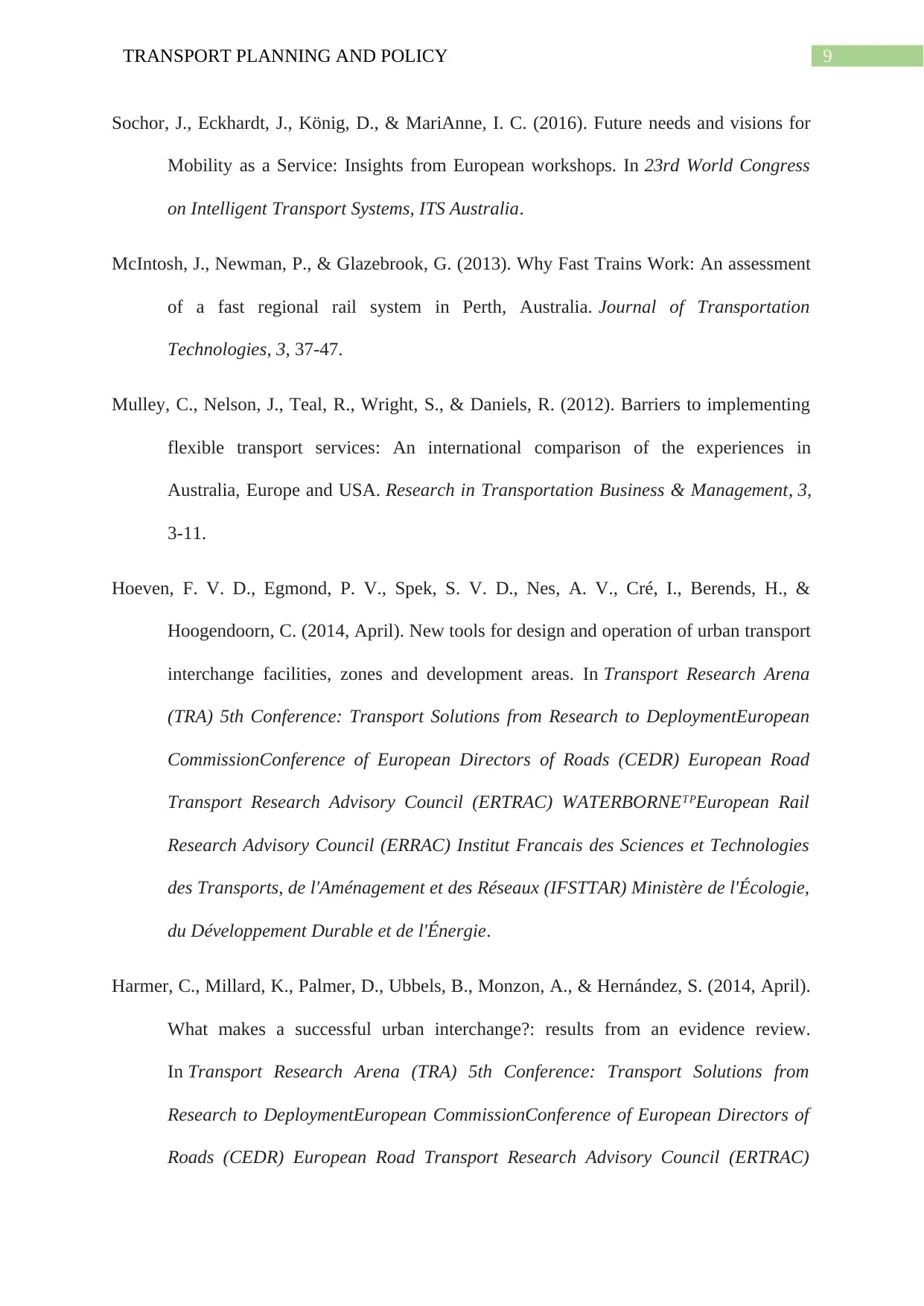
9TRANSPORT PLANNING AND POLICY
Sochor, J., Eckhardt, J., König, D., & MariAnne, I. C. (2016). Future needs and visions for
Mobility as a Service: Insights from European workshops. In 23rd World Congress
on Intelligent Transport Systems, ITS Australia.
McIntosh, J., Newman, P., & Glazebrook, G. (2013). Why Fast Trains Work: An assessment
of a fast regional rail system in Perth, Australia. Journal of Transportation
Technologies, 3, 37-47.
Mulley, C., Nelson, J., Teal, R., Wright, S., & Daniels, R. (2012). Barriers to implementing
flexible transport services: An international comparison of the experiences in
Australia, Europe and USA. Research in Transportation Business & Management, 3,
3-11.
Hoeven, F. V. D., Egmond, P. V., Spek, S. V. D., Nes, A. V., Cré, I., Berends, H., &
Hoogendoorn, C. (2014, April). New tools for design and operation of urban transport
interchange facilities, zones and development areas. In Transport Research Arena
(TRA) 5th Conference: Transport Solutions from Research to DeploymentEuropean
CommissionConference of European Directors of Roads (CEDR) European Road
Transport Research Advisory Council (ERTRAC) WATERBORNEᵀᴾEuropean Rail
Research Advisory Council (ERRAC) Institut Francais des Sciences et Technologies
des Transports, de l'Aménagement et des Réseaux (IFSTTAR) Ministère de l'Écologie,
du Développement Durable et de l'Énergie.
Harmer, C., Millard, K., Palmer, D., Ubbels, B., Monzon, A., & Hernández, S. (2014, April).
What makes a successful urban interchange?: results from an evidence review.
In Transport Research Arena (TRA) 5th Conference: Transport Solutions from
Research to DeploymentEuropean CommissionConference of European Directors of
Roads (CEDR) European Road Transport Research Advisory Council (ERTRAC)
Sochor, J., Eckhardt, J., König, D., & MariAnne, I. C. (2016). Future needs and visions for
Mobility as a Service: Insights from European workshops. In 23rd World Congress
on Intelligent Transport Systems, ITS Australia.
McIntosh, J., Newman, P., & Glazebrook, G. (2013). Why Fast Trains Work: An assessment
of a fast regional rail system in Perth, Australia. Journal of Transportation
Technologies, 3, 37-47.
Mulley, C., Nelson, J., Teal, R., Wright, S., & Daniels, R. (2012). Barriers to implementing
flexible transport services: An international comparison of the experiences in
Australia, Europe and USA. Research in Transportation Business & Management, 3,
3-11.
Hoeven, F. V. D., Egmond, P. V., Spek, S. V. D., Nes, A. V., Cré, I., Berends, H., &
Hoogendoorn, C. (2014, April). New tools for design and operation of urban transport
interchange facilities, zones and development areas. In Transport Research Arena
(TRA) 5th Conference: Transport Solutions from Research to DeploymentEuropean
CommissionConference of European Directors of Roads (CEDR) European Road
Transport Research Advisory Council (ERTRAC) WATERBORNEᵀᴾEuropean Rail
Research Advisory Council (ERRAC) Institut Francais des Sciences et Technologies
des Transports, de l'Aménagement et des Réseaux (IFSTTAR) Ministère de l'Écologie,
du Développement Durable et de l'Énergie.
Harmer, C., Millard, K., Palmer, D., Ubbels, B., Monzon, A., & Hernández, S. (2014, April).
What makes a successful urban interchange?: results from an evidence review.
In Transport Research Arena (TRA) 5th Conference: Transport Solutions from
Research to DeploymentEuropean CommissionConference of European Directors of
Roads (CEDR) European Road Transport Research Advisory Council (ERTRAC)
Paraphrase This Document
Need a fresh take? Get an instant paraphrase of this document with our AI Paraphraser

10TRANSPORT PLANNING AND POLICY
WATERBORNEᵀᴾEuropean Rail Research Advisory Council (ERRAC) Institut
Francais des Sciences et Technologies des Transports, de l'Aménagement et des
Réseaux (IFSTTAR) Ministère de l'Écologie, du Développement Durable et de
l'Énergie.
Chowdhury, S., & Ceder, A. (2013). Definition of planned and unplanned transfer of public
transport service and user decisions to use routes with transfers. Journal of public
transportation, 16(2), 1.
Guo, Z., & Wilson, N. H. (2011). Assessing the cost of transfer inconvenience in public
transport systems: A case study of the London Underground. Transportation
Research Part A: Policy and Practice, 45(2), 91-104.
Iseki, H., & Taylor, B. D. (2009). Not all transfers are created equal: Towards a framework relating
transfer connectivity to travel behaviour. Transport Reviews, 29(6), 777-800.
WATERBORNEᵀᴾEuropean Rail Research Advisory Council (ERRAC) Institut
Francais des Sciences et Technologies des Transports, de l'Aménagement et des
Réseaux (IFSTTAR) Ministère de l'Écologie, du Développement Durable et de
l'Énergie.
Chowdhury, S., & Ceder, A. (2013). Definition of planned and unplanned transfer of public
transport service and user decisions to use routes with transfers. Journal of public
transportation, 16(2), 1.
Guo, Z., & Wilson, N. H. (2011). Assessing the cost of transfer inconvenience in public
transport systems: A case study of the London Underground. Transportation
Research Part A: Policy and Practice, 45(2), 91-104.
Iseki, H., & Taylor, B. D. (2009). Not all transfers are created equal: Towards a framework relating
transfer connectivity to travel behaviour. Transport Reviews, 29(6), 777-800.
1 out of 11
Related Documents
Your All-in-One AI-Powered Toolkit for Academic Success.
+13062052269
info@desklib.com
Available 24*7 on WhatsApp / Email
![[object Object]](/_next/static/media/star-bottom.7253800d.svg)
Unlock your academic potential
Copyright © 2020–2025 A2Z Services. All Rights Reserved. Developed and managed by ZUCOL.


![Project Management Fundamentals and Practices Report - [University]](/_next/image/?url=https%3A%2F%2Fdesklib.com%2Fmedia%2Fimages%2Ffn%2Fcc45fac9bb8e435ca795906f2caf1048.jpg&w=256&q=75)


